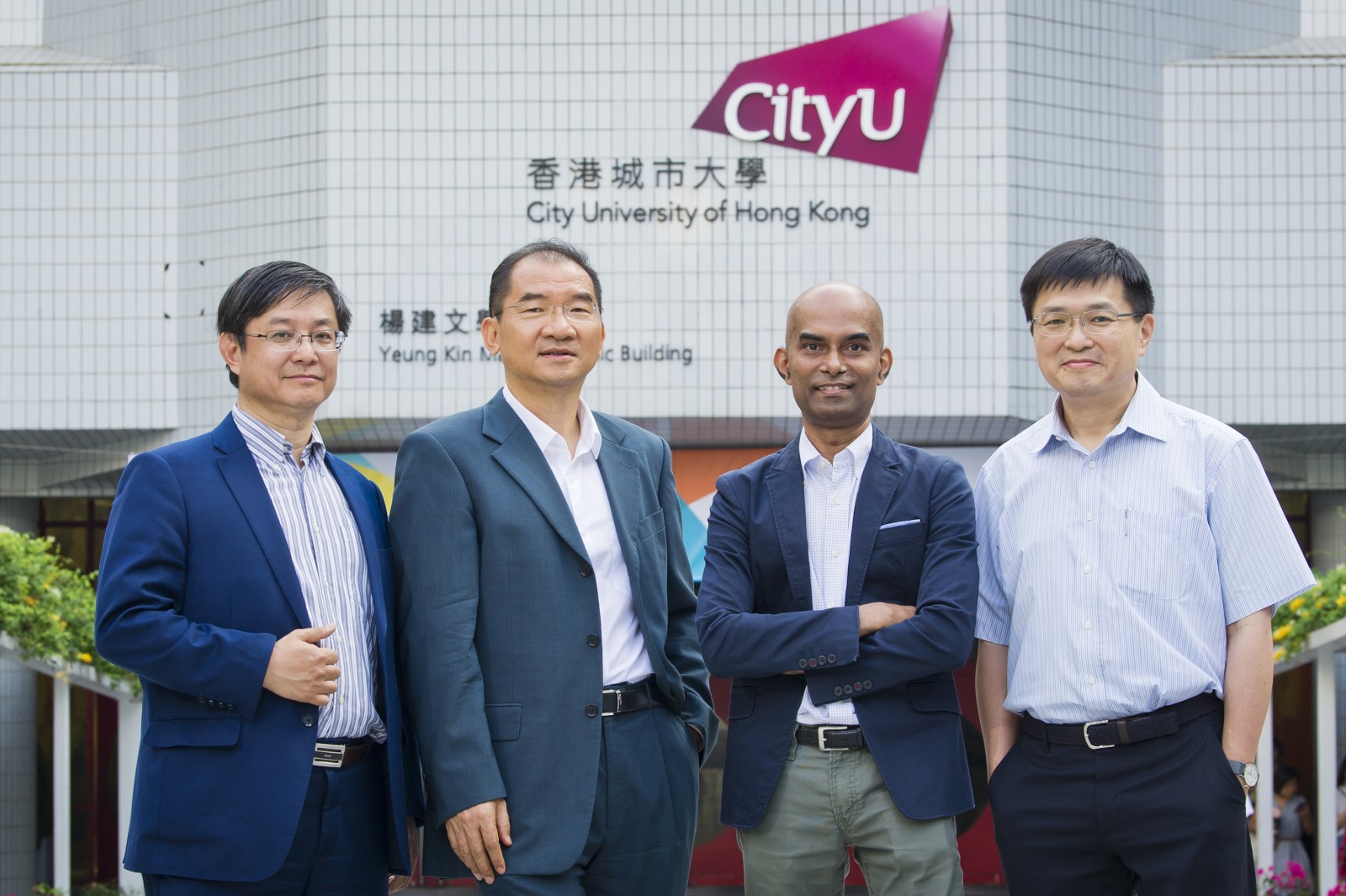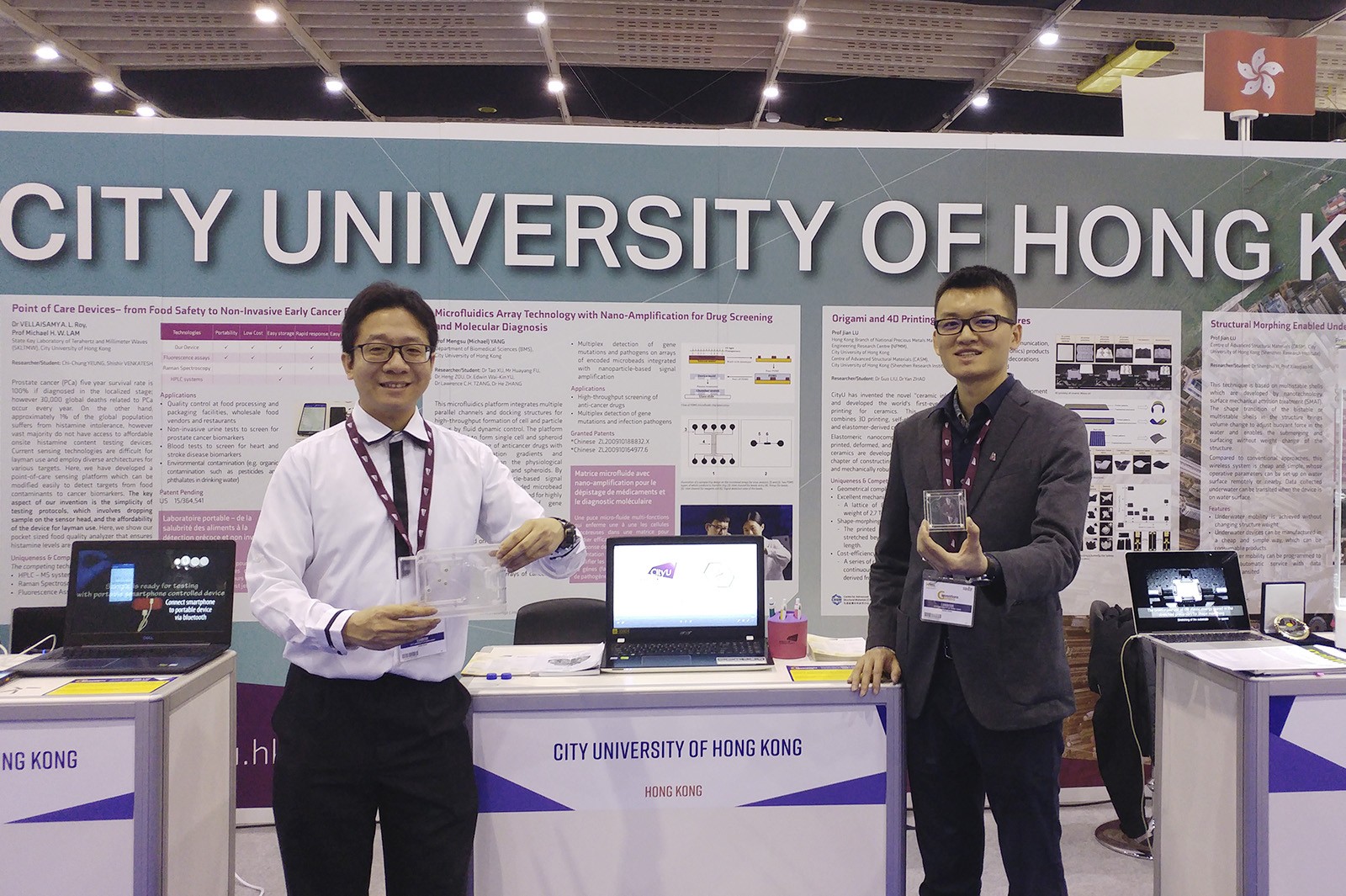CityU wins two golds and two silvers at the International Exhibition of Inventions of Geneva

Researchers from City University of Hong Kong (CityU) received four awards, including two Gold Medals and two Silver Medals at the 47th International Exhibition of Inventions of Geneva, held in Switzerland.
“Point of Care Devices – from Food Safety to Non-Invasive Early Cancer Detection”, developed by Dr Roy Vellaisamy, Associate Professor in the Department of Materials Science and Engineering, who is also a member of State Key Laboratory of Terahertz and Millimeter Waves, and Professor Michael Lam Hon-wah, from the Department of Chemistry, and their research team, received the Gold Medal.

Approximately 1% of the global population suffers from biogenic amines intolerance. Biogenic amines can be found when bacteria grow in food, so the existence of biogenic amines is one of the indicators of food decay. However, conventional tests for biogenic amines take about one day in a laboratory, and most people do not have access to affordable onsite testing devices. In addition, there are about 30,000 deaths related to prostate cancer (PCa) a year globally, but the 5-year relative survival rate for PCa patients is nearly 100% if diagnosed at the localised stage.
The new system developed by the CityU research team was originally designed for the detection of contaminants in food with concentrations of less than 0.2ppm (parts per million). It contains a nanosensor that prescreens food samples on the spot, using a mobile phone, and identifies the presence of biogenic amines and formaldehyde in 10 to 25 minutes.
The research team went a step further by modifying the point-of-care sensing platform to detect cancer biomarkers, such as conducting non-invasive urine tests to screen for prostate cancer biomarkers. This approach helps increase the survival rate of PCa patients, as early detection is crucial for increasing the chance of successful treatment.
Other members of the research team included Dr Shishir Venkatesh and Mr Yeung Chi-chung.

The other Gold Medal project is “Microfluidics Array Technology with Nano-Amplification for Drug Screening and Molecular Diagnosis”, developed by a research team led by Professor Michael Yang Mengsu, Yeung Kin Man Chair Professor of Biomedical Sciences and Head of the Department of Biomedical Sciences.
The team developed a microfluidics platform that integrates multiple parallel channels and docking structures for capturing circulating tumour cells and for high-throughput formation of cell and particle arrays by fluid dynamic control.
By using a specially designed microfluidic chip, a single tumour cell and spheroid arrays can be formed for the screening of anticancer drugs with different concentration gradients and combinations. This screening can test the effectiveness of the current treatment, and identify the most efficient drug and optimal drug concentration.
The platform can also be used for highly sensitive multiplex detection of gene mutations and infection pathogens on arrays of coded microbeads integrated with nanoparticle-based signal amplification. This detection of gene mutations helps detect drug targets for precise medicine. Detecting infection pathogens can benefit people in disease control and early diagnosis or treatment of infectious diseases.
The award-winning technology platform has been licensed to Cellomics, a CityU TSSSU company, for further development into products for disease detection and diagnosis in hospitals and clinical laboratories, and for pharmaceutical companies to help in new drug discoveries.
The research team also includes Dr Xu Tao, Mr Fu Huayang, Dr Henry Zou Heng, Dr Edwin Yu Wai-kin, Dr Lawrence Tzang and Dr Zhang He.

“Origami and 4D Printing of Ceramic Structures”, invented by Professor Lu Jian and his research team, won a Silver Medal. Professor Lu is Vice-President (Research and Technology) of CityU and is also the Director of the Hong Kong Branch of the National Precious Metals Material Engineering Research Centre, the Centre of Advanced Structural Materials, and the CityU Shenzhen Research Institute.
This project developed a novel “ceramic ink”, which is a mixture of polymers and ceramic nanoparticles, making possible the world’s first-ever 4D printing for ceramics.
4D printing usually means 3D-printed objects that can re-shape themselves over time when affected by external stimuli, such as mechanical force, temperature, or a magnetic field. This 4D printing of ceramics combines 3D printing with a programmable pre-strain. When the stretched ceramic precursors are released, they undergo shape morphing as designed.
The 4D-printed ceramics are mechanically robust and come in large sizes with high strength compared to other printed ceramics. They can be applied in the manufacture of electronic products, since ceramic materials are better than metallic materials for transmitting electromagnetic signals. They also have high potential for the aerospace field and space exploration.
Other members on the research team are Dr Liu Guo and Dr Zhao Yan.

“Structural Morphing Enabled Underwater Quality Monitoring System”, another project developed by Professor Lu and his research team, also received a Silver Medal.
This technique provides a new approach to achieving underwater mobility in an efficient, economical and robust way. It includes multi-stable shells that are developed by nanotechnology surface mechanical attrition treatment (SMAT). The shape transitions of the bistable or multistable shells in the structure create a volume change to adjust to the buoyant force in the water and enable submerging and surfacing without changing the weight of the structure. Data collected underwater at different depths can be transmitted when the device is on the surface of the water. The research results can be applied to underwater vehicles, monitoring and surveillance, and can be transformed into consumable products, such as underwater devices.
The research team members include Professor He Xiaoqiao and Dr Yi Shenghui.
The 47th International Exhibition of Inventions of Geneva, which was held from 10 to 14 April, 2019 in Switzerland, is one of the biggest global events showcasing innovations and inventions from around the world.